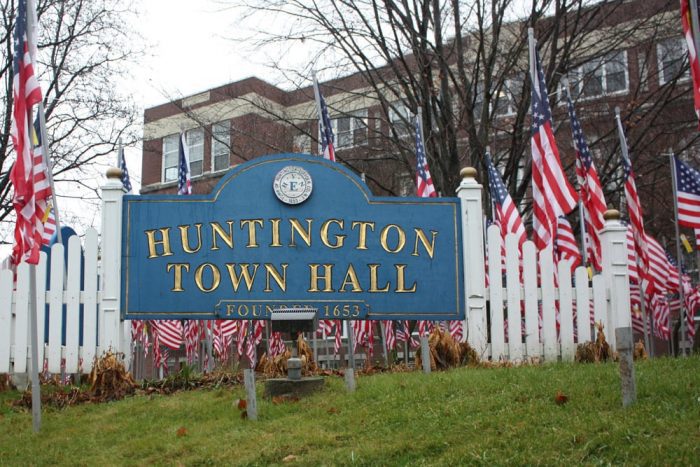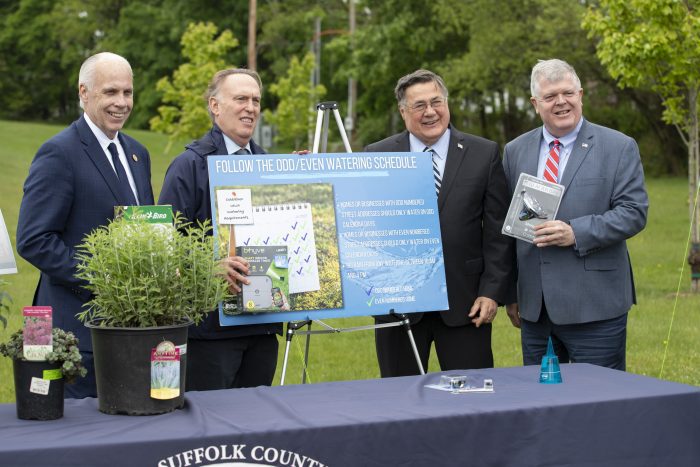The Town of Smithtown saw heavy rains and flash flooding last night, enduring approximately ten inches in total, as the storm regenerated across Suffolk County throughout the night and early morning. The Town of Smithtown has compiled a detailed assessment of damage, flooding, and areas of concern in addition to providing important information regarding storm cleanup, and contact information for those in need of further assistance.
“We were fortunate in comparison to surrounding areas, much in part due to proactive measures and recent upgrades made to infrastructure, elevated roadways, and state-of-the-art engineering at Smithtown’s most vulnerable areas. I want to commend our crews working throughout the night. Public Safety, Parks, and Highway teams have been working around the clock to clear, assess and repair the damage, in the wake of the storm, which was unpredicted by meteorologists. I also want to commend our volunteer Fire Departments, FRES, our Office of Emergency Management, and Fire Marshals who were out in these dangerous conditions overnight, performing water rescues, extracting stranded drivers, responding to emergency calls and assisting our neighbors in Stony Brook,” said Smithtown Town Supervisor Ed Wehrheim.
“Public Safety even used their Drone to assist the Smithtown Fire Department boat to rescue two individuals who were stranded from a home. The level of communication, bravery and teamwork over these past 24 hours has been extraordinary. I would also like to commend our County Executive, Ed Romaine for leaping into action immediately to declare a State of Emergency for the area. Finally, I’d recommend that everyone access the Town of Smithtown Mobile App for notifications regarding road detours, areas to avoid and updates on the storm cleanup. We will not stop until flooding concerns have been addressed, the roads are clear, and our residents can safely resume daily routines,” added Supervisor Wehrheim.
Town Damage Assessment:
The headwaters of the Nissequogue have crested at Paul T. Given Park. Councilman Tom Lohmann, Superintendent Robert Murphy and our emergency response teams are currently on scene together with Suffolk County Fire Rescue and Emergency Services (FRES) and our Planning Department to alleviate water conditions, in hopes of preventing the river from cresting over NYS Route 25a. The basement of the building next to the park (formerly the Oasis) has flooded up to the first floor. Smithtown’s Parks Department is currently on scene and is going to remove accumulated debris under the culdesac to alleviate rising waters. This will also allow the MTA to get into their property to inspect the train trestle. Currently, train service is suspended between Port Jefferson and Kings Park in both directions due to flooding from the Nissequogue River west of Smithtown.
Maple Avenue at Millers Pond (Wildwood Ln to Darling Ave) is closed due to overflow conditions. The Smithtown Highway Department, alongwith Deputy Superintendent Jim Duetch are currently on scene with Suffolk County Parks to mitigate flooding and ensure the culvert remains stable. Both of these areas (Paul T Given Park & Millers Pond) are of critical importance to address as more rainfall is predicted for this afternoon.
The Smithtown Parks Department has been operating the cleanup at Town Hall, which took in close to four feet of water in the basement and is currently operating on backup power. The Parks Department building in Kings Park sustained flooding damage to the shop area and vehicles were badly flooded.
As of this morning, we’ve estimated approximately 50 town trees (in the town right of way) were either uprooted or down. Highway crews are currently working to remove these trees from the roadways.
Parks & Beaches:
Landing Country & Golf Club sustained washouts and drainage issues in addition to damage on the 9th hole of the course. Parks crews have been dispatched and are currently working on repairs.
Boaters with vessels in slips and the town mooring fields should ensure that lines are secured. There have been a few instances where boats have come loose.
The bathroom area at Whitman Hollow sustained some flooding issues. Parks Crews have already been dispatched to handle cleanup.
Callahan’s Beach only sustained a few down trees as of this morning. The incredible state of the art engineering of the rebuild had its first real test and aced with flying colors.
The elevation of Long Beach Road also handled extreme rain without incident. No flooding was reported.
LIRR Train Service: LIRR Train service is suspended from Port Jefferson to Kings Park until further notice.
ROAD CLOSURES/DETOURS:
- Maple Ave is closed due to road flooding from Wildwood Ln to Darling Ave. Use an alternative route.
- North Country Road from Mills Pond road all the way up north, is closed and impassable due to flooding. Use an alternative route.
- West Main St Smithtown from Maple Ave to Edgewood Ave Closed due to Flooding. Use an alternate Route.
Residents can stay informed about the storm and get up to the minute updates via the Town of Smithtown Mobile App, which is free to download on Google Play and the App Store.
Safety Reminders: Do not attempt to drive over a flooded road. Turn around and go another way. DID YOU KNOW? Six inches of fast moving flood water can knock you off your feet. A depth of two feet of water will float your car. Never try to walk, swim or drive through such swift water.
Keep children from playing in floodwaters or near culverts and storm drains.
Resident Safety Post Storm:
Residents should attempt to keep all brush, tree branches and storm debris clear from blocking fire hydrants and storm drains.
Public Safety and Smithtown Fire Marshals would like to remind residents using generators to take a moment to confirm that the exhaust is facing outwards and at least 20’ away from a building, to prevent CO poisoning and fires caused by incorrectly positioned generators.
Highway crews are working with PSEG to clear the roads of any remaining trees safely, and have begun hauling debris/brush today. The Highway Department led by Superintendent Robert Murphy, has cleanup crews assigned to every hamlet.
NOTE: Fallen trees can hide downed cables or entangled power lines, even if the power is out.
Power:
As of this morning, there are less than 20 homes within the township who are without power.
To report and receive status updates on an outage Text OUT to PSEGLI (773454) or to report an outage online visitwww.psegliny.com
To register, have your account number available and text REG to PSEGLI (773454)
Downed wires should always be considered “live.” Do not approach or drive over a downed line and do not touch anything contacting the wire. To report a downed wire, call PSEG Long Island’s 24-hour Electric Service number: 1-800-490-0075
Stranded Vehicles: If there is an emergency, please dial 9-11 immediately. All non life-threatening calls can be directed to the Department of Public Safety by calling (631) 360-7553
Report Gas Outages or Emergencies: If you smell gas anywhere, including in your home, go outside and call National Grid 24 hour hotline at 1-800-490-0045 or dial 911 immediately.
LIRR Commuter Travel Information: For information regarding delays or travel questions, contact the LIRR 24 hour travel information center at 718-217-5477
Local Fire & Police Phone Numbers: In an emergency dial 9-1-1
- Suffolk County Police Department: For non-emergencies, contact 631-852-COPS (2677). Dial 9-1-1 ONLY for life-threatening emergencies.
- Smithtown Fire Rescue Communications: 631-265-1500 for fire and EMS emergencies in the Smithtown, Kings Park, and Hauppauge Fire Districts.
- Suffolk County Fire Rescue and Emergency Services: Dial 911 for fire and EMS emergencies in the St. James, Nesconset, and Nissequogue Fire Districts.
- Commack Fire Department: 631-499-5777 for fire emergencies in the Commack Fire District.
To Report Flooding or Road Concerns: To report flooding, drainage issues, and other storm related conditions along the roads, please contact the Highway Department at (631) 360-7500. NOTE: Flooding in basements are the
Downed Street Trees: Trees within the town’s right of way (alongside a town road) are in general the responsibility of the Highway Department. Residents with down trees on property lines can call the Department of Environment and Waterways (DEW) at (631) 360-7514 to inspect the tree and determine the best course of action. Trees that are not in the town’s right of way are the responsibility of the resident.
Elderly Neighbors & Special Needs individuals: Always check on your neighbors living with disabilities, special needs or senior citizens. Make sure they have an emergency phone, plenty of water, food and blankets. Ask if they have someone to call in the event of an emergency. If further intervention is required please contact the Senior Citizens Department at (631) 360-7616 or the Office for People with Disabilities at (631) 360-7642
Wildlife Rescue & Lost Pets:
Smithtown Animal Control Officers are ready to respond to calls for wildlife in distress or to report lost pets. Animals in distress, strays or other loose domestic or wild animals can be reported to the Smithtown Animal Shelter and Animal Control at (631) 360-7575
Suffolk 311: Suffolk County 311 is a central call center available to residents who do not know which number to call for any non-emergency. Residents can reach the 311 line Monday through Friday from 9 a.m. to 4:30 p.m. or leave messages after hours.
Damage Self-Reporting Tool: Homes & Businesses: In collaboration with affected counties, New York State has developed an online form allowing residents to self-report damages to their homes and/or businesses. The purpose of this form is solely to collect information that may help State and local officials identify supplemental damages to develop and augment potential requests for available federal assistance programs. NOTE: Reporting damage is a voluntary activity and is not a substitute for reporting damage to your insurance agency, nor does it guarantee disaster relief assistance. (Do not use this form to report immediate, life-threatening needs. Call 911)
LINK TO FORM: Smithtownny.gov/CivicAlerts.aspx?AID=2879




















